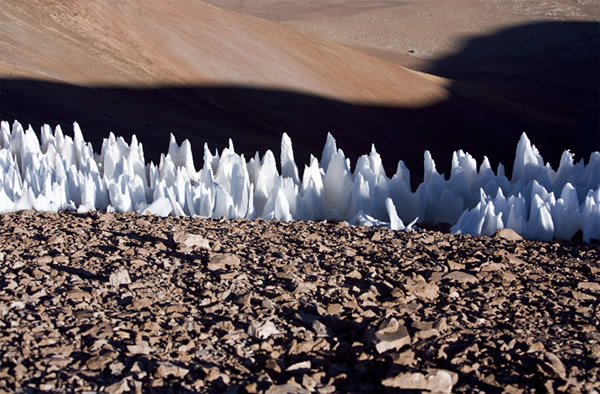Is Europa Too Prickly to Land On?
A field of penitentes in Chile -- could the same features on the Jovian moon Europa pose a challenge for surface missions?
A deadly bed of icy javelins could be awaiting any spacecraft that tries to land on some parts of the ice-covered world Europa, say researchers who have carefully modeled the ice processes at work on parts of the Jovian moon to detect features beyond the current low resolution images.
If the prediction of long vertical blades of ice is correct, it will not only help engineers design a lander to tame or avoid the sabers, but also help explain a couple of nagging mysteries about the strange moon.
Currently, the very best images of Europa only see 10 meters per pixel, at best, said Daniel Hobley of the University of Colorado. That means that if giant ice daggers do exist, they could still be several meters long and still escape detection.
To learn more, Hobley and his colleagues looked to Chile, where high in the mountains there are peculiar icy features called penitentes that are not found in polar regions.
"Penitentes are very, very sharp blades and spikes of ice," said Hobley. "They are famously well developed in Chile and only develop in the tropics on Earth."
The reason for the tropical location is that in order to sculpt the blade, the sun's rays must shine down almost vertically throughout the year so the light is always drilling down at the bottom of the crevices, between the blades, rather than the sides of the blades. In contrast, at higher latitudes the sun's angle changes dramatically through even a single season, so that light would shine on the sides of the blades and melt them before they had time to develop to any significant size.
The researchers also predict that penitentes, perhaps up to five meters long, could crowd Europa's surface in a wide band centered on the equator. Beyond that band there might be less hostile features called sun cups.
"Sun cups are amazingly open bowls on snow ice," Hobley explained. "They look like giant thumbprints. They sit next to each other and are a half meter in width, approximately."
Surprisingly, there is already circumstantial evidence that the penitentes might exist on Europa.
Temperature maps of the dark side of Europa have long puzzled scientists because they show a band of unusually cold surface centered on the equator. Penitentes could explain that if they act as cooling fins and speed the cooling of that surface.
Also, radar signals aimed form Earth to Europa and bounced off the surface also show an inexplicable band of poor radar reflection at low latitudes. This could be caused by the baffle-like surfaces of penitentes that are scattering the radar signal, explained Hobley, who is presenting a poster about the work on Oct. 30 at the meeting of the Geological Society of America in Denver.
The new modeling is already a critical factor in the ongoing NASA planning for the exploration of Europa.
"This is a game changer," said planetary scientist Don Blankenship of the University of Texas in Austin. Blankenship has been involved in NASA's planning process for sending a reconnaissance spacecraft and eventually a lander to Europa. Already the new ice models have spurred changes in the instruments being planned for the Europa Clipper mission, hopefully to launch in November 2021, which will do extensive reconnaissance work to prepare the way for a future Europa lander.
“Clipper is getting a topographic imager with resolution of less than a meter.”
That should settle whether there are penitentes, Blankenship said, which directly affects where the future lander would be looking to set down.
Europa is the target of a lander because it shows signs of having a global liquid water ocean beneath its glacial surface and is one of the few places in the solar system that might harbor life.
“This is a big deal,” said Blankenship. “Everyone wants this lander to go.”(Oct 27, 2013 07:00 AM ET // by Larry O'Hanlon)












